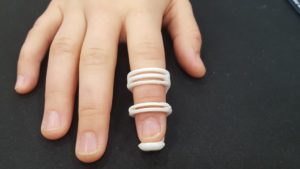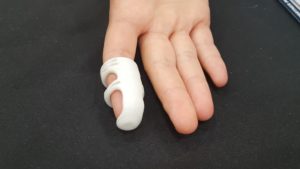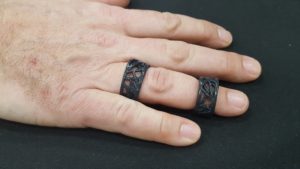 Broken bones and style don’t always go together, but modern technology is changing both the means and the aesthetics of recuperation. 3D printed braces and splints have become more common, from homemade finger splints to devices made on the International Space Station, as customized stabilizers offer a new flexibility in the healing process. One of the earliest such efforts in this space is a project out of Lithuania that offers a “stylish approach to healthcare,” as Vilnius-based Creatus showcases its EXO line of 3D printed splints. During this week’s SOLIDWORKS World in LA, I enjoyed the opportunity to sit down with Creatus Head Designer and CCO Gintarė Černiauskaitė, who has been working for about five years now on the project.
Broken bones and style don’t always go together, but modern technology is changing both the means and the aesthetics of recuperation. 3D printed braces and splints have become more common, from homemade finger splints to devices made on the International Space Station, as customized stabilizers offer a new flexibility in the healing process. One of the earliest such efforts in this space is a project out of Lithuania that offers a “stylish approach to healthcare,” as Vilnius-based Creatus showcases its EXO line of 3D printed splints. During this week’s SOLIDWORKS World in LA, I enjoyed the opportunity to sit down with Creatus Head Designer and CCO Gintarė Černiauskaitė, who has been working for about five years now on the project.
Černiauskaitė, now a PhD student in design, began work on the EXO project in 2013 as part of her masters degree at the Vilnius Academy of Arts, an institution home to ingenuitive design projects. Creatus was established in 2015 as its own business entity, bringing together a team dedicated to advances in healthcare and a commitment to active lifestyles. The collection of 3D printed splints was not initially targeted as a project for 3D printing — that connection came some way into the work, Černiauskaitė explained.
“After we did a project, we saw that 3D printing was the best technology to make it. It was in the middle of the work that we found it,” she told me.
“The structure, this open design, is part of the healing process, not because of 3D printing. Of course it is now connected because it has to be 3D printed. We needed a cast that was light and waterproof, and allowed as much naked skin as possible. Why we need it is because we want to start doing physical therapy such as ultrasound or light therapy on day one. Now, you get a standard plastic cast and you have to wait three to four weeks for the cast to be taken off to do therapy. A person not moving the bone does not help — we strive to remove these complications. By having a cast to do physical therapy without taking it off, it means it is more secure, and can heal quick, hopefully in a stylish way.”
While 3D printed splints are becoming more common now, when Černiauskaitė initially began work on the EXO splints it was earlier days. She noted that “we were second on the market” — their first prototype, in 2013, was ready to share “two weeks after the very first one in New Zealand.” Following the publication of EXO’s design, the interest was immediate — including from copycats.
“Then there were copies of our ideas, some even copied our pamphlets exactly, they took them word for word, which was stressful — but it also says we’re doing the right thing if they want to copy it,” she explained.
“Then we still want to be the first, so we do something more. The market is mostly arms now. So we did a series and are now working on smart casts. This spring, we are planning to hopefully develop these so that in the summer we can make a smart leg splint. We will implement all those rehabilitation procedures into the splint, with conductive materials in the splint — so you don’t have to always go to the doctor, you can go to an app and hit play and do it anywhere you are. You can have a holiday and keep healing quick.”
While the line is expanding, its starting point is much more pointed — and personal.
“I broke my finger a few months ago,” Černiauskaitė told me. “I started with EXO because I make a lot of things, but a few months ago I broke my finger. I went to the surgeon, but they could not make a cast because it was too big and heavy — I had just broken it at the top by my fingernail. Basically all finger casts are for the whole finger. This also leads to more complications because then I cannot move two joints. So I designed a new type that is just at the top, so you do not get hurt; as far as I know, it was the first on the market because no one else is making tiny splints.”
- Gintarė’s fingertip splint
All of the EXO splints are lightweight, designed with wearability in mind. The largest cast in the current line, which extends from the finger to above the elbow, weighs 60 grams — that’s three times lighter than a typical iPhone, Černiauskaitė noted. The small finger splint that she was wearing weighs in at just four grams.
“The idea is to do it in style and of course in a good professional way,” she said of the design process. “This lets the patient shower, lets the skin breathe. They are very lightweight and all still very strong. With 3D printing, it really helps us to make it personalized and fit every person.”
The ability to shower and continue living life as normal while healing is an important consideration for those designing medical devices, and are major benefits of 3D printed options. Currently, Creatus has designs for arm, wrist, finger, and neck splints, Černiauskaitė explained, and is about to make leg casts as well.
- A larger finger splint modeled by Creatus Project Manager Stasys Černiauskas
For each splint, Černiauskaitė and her team have developed three equally strong patterns so a patient can select the style they want, as well as the color of material available for 3D printing. These are, after all, “not only a cast, but a stylish thing,” which will be worn for weeks during recovery.
Creatus’ material of choice for the FFF-based 3D printing process is what Černiauskaitė calls an “extra special blend of ABS.”
“It is not the standard ABS, that doesn’t really work. We had also tried SLS 3D printing with nylon, but that didn’t work very well — it was too flexible,” she told me.
“We really care that it is recyclable — not only before with the material, but after with the product. What we make here will be trash in four to six weeks, maybe eight weeks, tops. Because it’s made for a person specifically, it’s not reusable for someone else. So it’s easy to take apart and shred and recycle, so a cast can be a cast again.”
The incorporation of 3D printing into EXO splints and the search for the perfect material have not been the only technical design considerations Černiauskaitė and her team have had to make; they are also constantly running ahead of currently available technologies. While 3D printing has developed at a sprint over the last few years, with capabilities in strength and geometries expanding at breakneck speed (pardon the pun), the young technology is still developing.
“With our project, our ideas are about six months to two years ahead of technology. We keep having to wait for the tech to pick up — speed, color, material, what is possible with 3D printing, and with price,” Černiauskaitė said of the growing pains.
“With our first splint, it was slower and expensive; now it’s quicker and half the price. With smart casts, we have thought how can we combine different materials and colors. In SOLIDWORKS, we are finding people that are thinking about making what we need, we have the design. This is also driving that field now, which is nice.”
SOLIDWORKS, for its part, was seen throughout SWW18 as being made of a team and supported by a vast user base all of people truly dedicated to advances; it’s no surprise that SOLIDWORKS enables progress for the EXO splints.
In addition to working with dedicated design software and support, the Creatus team have been learning from other real-world experiences, from Černiauskaitė’s breaking her finger to the feedback of healthcare professionals.
“A lot of things come from experience. We also developed our casts with the doctors — consultations with Lithuanian Olympics sports center, surgeons, rehabilitation therapists. It’s not just us, we did the research, showed them the process, and they advised how to develop. So far, their reviews are quite good,” Černiauskaitė told me.
EXO finger casts are already being sold, and Creatus is working on bringing other designs to the market. More testing and development — “which is quite normal for this field” — is in progress as additional market launches are on the horizon. Černiauskaitė noted that they are starting in Europe, “with sports people and military; those are the markets that really care about performance. As always happens, from those people it goes to the everyday person.”
Discuss SOLIDWORKS World 2018, 3D printed splints, and other 3D printing topics at 3DPrintBoard.com or share your thoughts below.
[All photos: Sarah Goehrke]
Subscribe to Our Email Newsletter
Stay up-to-date on all the latest news from the 3D printing industry and receive information and offers from third party vendors.
Print Services
Upload your 3D Models and get them printed quickly and efficiently.
You May Also Like
Making 3D Printing Personal: How Faraz Faruqi Is Rethinking Digital Design at MIT CSAIL
What if your 3D printer could think more like an intelligent assistant, able to reason through a design idea, ask questions, and deliver something that works exactly the way the...
Reinventing Reindustrialization: Why NAVWAR Project Manager Spencer Koroly Invented a Made-in-America 3D Printer
It has become virtually impossible to regularly follow additive manufacturing (AM) industry news and not stumble across the term “defense industrial base” (DIB), a concept encompassing all the many diverse...
Heating Up: 3D Systems’ Scott Green Discusses 3D Printing’s Potential in the Data Center Industry
The relentless rise of NVIDIA, the steadily increasing pledges of major private and public investments in national infrastructure projects around the world, and the general cultural obsession with AI have...
Formlabs Teams Up with DMG MORI in Japan
In late June, Nick Graham, Chief Revenue Officer at Formlabs, announced on LinkedIn that the company had partnered with DMG MORI, one of the world’s leading machine tool companies, to...








































